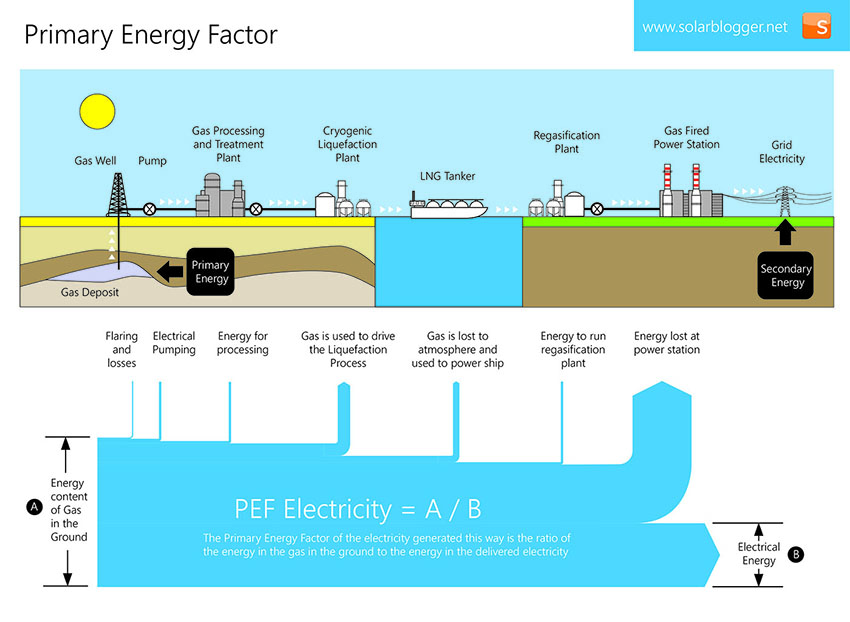Primary Energy
Primary energy is a form of energy that is found in nature which has not been subjected to any artificial (human) conversion process. It is the energy contained in materials such as oil, natural gas, and coal which can be released by burning them.
The process of converting primary energy into other, more useful, forms of energy, involves energy overheads and efficiency losses and these mean that more primary energy is needed than is delivered as useful energy (heating for a building or electricity). By way of example, let's follow the path of natural gas extracted from a giant gas field in Qatar and destined for the UK to make electricity in a power station (illustrated above):
Once extracted from the underground reserves, the gas is pumped through a pipeline to a processing facility. Here it is cooled to -162C, the temperature at which it becomes liquid and loaded aboard a specialised Liquefied Natural Gas (LNG) tanker which transports it to the UK. The gas needs to be kept cold during transport and this is done by insulating the containers it is carried in and allowing some of the gas to vaporise off. Some (but not all) ships capture the gas and use it in turbines that drive the ship along.
At the UK port, the liquefied gas is transferred into storage and kept at a cold temperature to remain liquid. When it is needed it is re-gasified and pumped into to the UK gas network. Finally, it arrives at an electrical power station where the gas might be burnt in a modern Combined Cycle Gas Turbine (CCGT). This is the most efficient type of power - because in addition to the heat from the combustion being used to raise steam and drive a turbine, the exhaust gases drive a second turbine. The turbines drive rotating shafts which produce electricity in a generator set.
There are losses at every stage in this journey from gas deposit to electrical energy. From an energy point of view, losses include the primary energy content of electricity or other fuels used as well as any burning or losses of the natural gas itself along the way.
A proportion of the gas is lost to the atmosphere and some may be flared (burnt off) at the rig or as part of the process filling the LNG tanker pressure vessels and during transportation. The pumps to move the gas through the distribution system use electricity.
Up to 10% of the natural gas is bunt to drive turbo-compressors that refrigerate the gas to liquefy it for sea transport.
As it crosses the ocean, the LNG carrier will lose 0.1 - 0.25% of its gas each day. This is allowed to boil off to maintain the low temperatures - that means up to 5% of the shipment is lost between Qatar and the UK in a typical 18 day transit. In addition the carrier uses either oil or the transported gas itself to drive its engines. Some carriers can recycle the boil-off with re-liquefaction plant on board, but this also comes at an energy cost.
Gas sourced from the North Sea will consume less energy in its transportation than gas from Qatar or the USA, but taking a weighted average of all UK gas supplies (based on figures in SAP10.1) - energy or losses equivalent to around 12% of the heat energy in the gas is used up simply getting it to a house or power station in the UK.
The best CCGT power stations have a conversion efficiency of 54% (HHV) meaning that to generate one unit of electrical energy, gas with an energy content of 1.85 units must be burnt.
Putting all of these losses together - extraction, processing, transportation and then conversion to electricity - mean that to put 1 unit of electrical energy into the grid, you need to start off with gas in the ground that contains something like 2.1 units of heat energy - so the electricity generated this way is said to have a primary energy factor of 2.1
Primary Energy Factor for Grid Electricity
Other forms of electricity generation will have differing primary energy factors, so the average primary energy factor for grid electricity is a weighted average. This will include energy from solar panels, wind turbines, burning biomass and bio gas, nuclear power as well as gas and oil, each with their own primary energy factors.
Although solar panels convert electromagnetic (light) energy to electricity and wind turbines do the same with the kinetic energy of wind, because these resources are considered inexhaustible, the convention is that renewable energy of this type has a primary energy factor of 1.0
According to SAP 10.1, the weighted average primary energy factor for UK electricity in the period 2020-2025 is expected to be 1.51.
The primary energy factor for electricity also varies depending on the generation mix that is contributing to UK electricity supply at any given moment in time. SAP 10.1 uses monthly values to take into account that renewable energy contributes different amounts of energy as the seasons change.


